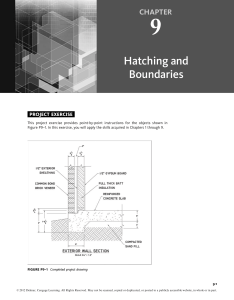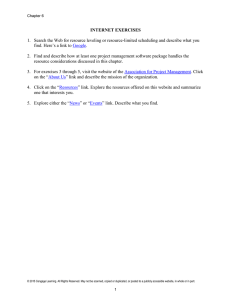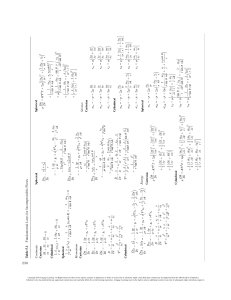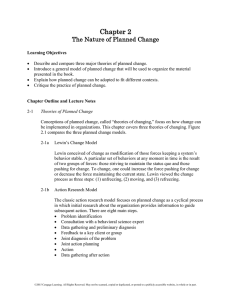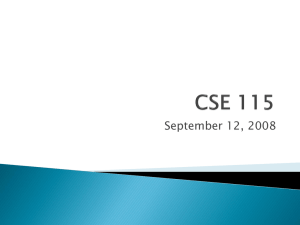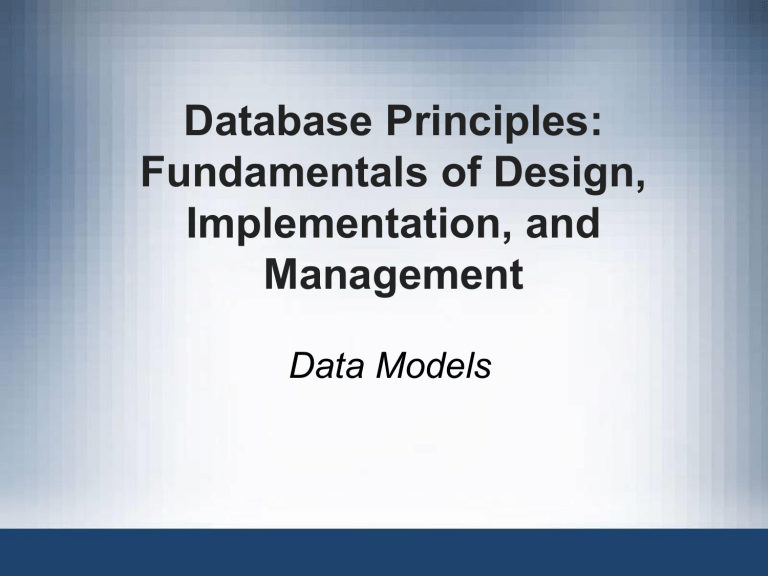
Database Principles: Fundamentals of Design, Implementation, and Management Data Models Database Systems, 10th Edition 1 © 2013 Cengage Learning. All Rights Reserved. This edition is intended for use outside of the U.S. only, with content that may be different from the U.S. Edition. May not be scanned, copied, duplicated, or posted to a publicly accessible website, in whole or in part. (Data Modeling Approach) WHY? • Designers, programmers, and end users see data in different ways • Different views of same data lead to designs that do not reflect organization’s operation • Data modeling reduces complexities of database design • Various degrees of data abstraction help reconcile varying views of same data 2 © 2013 Cengage Learning. All Rights Reserved. This edition is intended for use outside of the U.S. only, with content that may be different from the U.S. Edition. May not be scanned, copied, duplicated, or posted to a publicly accessible website, in whole or in part. (WHAT?) Data Modeling and Data Models • Model: an abstraction of a real-world object or event – Useful in understanding complexities of the real-world environment • Data models – Relatively simple representations of complex real-world data structures • Often graphical • Data modeling is iterative and progressive 3 © 2013 Cengage Learning. All Rights Reserved. This edition is intended for use outside of the U.S. only, with content that may be different from the U.S. Edition. May not be scanned, copied, duplicated, or posted to a publicly accessible website, in whole or in part. The Importance of Data Models • Facilitate interaction among the designer, the applications programmer, and the end user • End users have different views and needs for data • Data model organizes data for various users • Data model is an abstraction – Cannot draw required data out of the data model 4 © 2013 Cengage Learning. All Rights Reserved. This edition is intended for use outside of the U.S. only, with content that may be different from the U.S. Edition. May not be scanned, copied, duplicated, or posted to a publicly accessible website, in whole or in part. Where do we start? • Business Rules Database Alternatives, 10th Edition 5 © 2013 Cengage Learning. All Rights Reserved. This edition is intended for use outside of the U.S. only, with content that may be different from the U.S. Edition. May not be scanned, copied, duplicated, or posted to a publicly accessible website, in whole or in part. Business Rules • Descriptions of policies, procedures, or principles within a specific organization – Apply to any organization that stores and uses data to generate information • Description of operations to create/enforce actions within an organization’s environment – Must be in writing and kept up to date – Must be easy to understand and widely disseminated • Describe characteristics of data as viewed by the company/organization 6 © 2013 Cengage Learning. All Rights Reserved. This edition is intended for use outside of the U.S. only, with content that may be different from the U.S. Edition. May not be scanned, copied, duplicated, or posted to a publicly accessible website, in whole or in part. Business rules(usage..) • Used to define building blocks of data models Database Alternatives, 10th Edition 7 © 2013 Cengage Learning. All Rights Reserved. This edition is intended for use outside of the U.S. only, with content that may be different from the U.S. Edition. May not be scanned, copied, duplicated, or posted to a publicly accessible website, in whole or in part. Data Model Basic Building Blocks • Entity: anything about which data are to be collected and stored • Attribute: a characteristic of an entity • Relationship: describes an association among entities – One-to-many (1:M) relationship – Many-to-many (M:N or M:M) relationship – One-to-one (1:1) relationship • Constraint: a restriction placed on the data 8 © 2013 Cengage Learning. All Rights Reserved. This edition is intended for use outside of the U.S. only, with content that may be different from the U.S. Edition. May not be scanned, copied, duplicated, or posted to a publicly accessible website, in whole or in part. Business rules(discovery.) • How do we discover Business Rules? Database Alternatives, 10th Edition 9 © 2013 Cengage Learning. All Rights Reserved. This edition is intended for use outside of the U.S. only, with content that may be different from the U.S. Edition. May not be scanned, copied, duplicated, or posted to a publicly accessible website, in whole or in part. Discovering Business Rules • Sources of business rules: – – – – Company managers Policy makers Department managers Written documentation • Procedures • Standards • Operations manuals – Direct interviews with end users 10 © 2013 Cengage Learning. All Rights Reserved. This edition is intended for use outside of the U.S. only, with content that may be different from the U.S. Edition. May not be scanned, copied, duplicated, or posted to a publicly accessible website, in whole or in part. Importance of Business Rules • Standardize company’s view of data • Communications tool between users and designers • Allow designer to understand the nature, role, and scope of data • Allow designer to understand business processes • Allow designer to develop appropriate relationship participation rules and constraints 11 © 2013 Cengage Learning. All Rights Reserved. This edition is intended for use outside of the U.S. only, with content that may be different from the U.S. Edition. May not be scanned, copied, duplicated, or posted to a publicly accessible website, in whole or in part. Translating Business Rules into Data Model Components • Nouns translate into entities • Verbs translate into relationships among entities • Relationships are bidirectional • Two questions to identify the relationship type: – How many instances of B are related to one instance of A? – How many instances of A are related to one instance of B? 12 © 2013 Cengage Learning. All Rights Reserved. This edition is intended for use outside of the U.S. only, with content that may be different from the U.S. Edition. May not be scanned, copied, duplicated, or posted to a publicly accessible website, in whole or in part. Example • A student is allowed to register a maximum of 6 subjects. A subject can be registered by many students Database Alternatives, 10th Edition 13 © 2013 Cengage Learning. All Rights Reserved. This edition is intended for use outside of the U.S. only, with content that may be different from the U.S. Edition. May not be scanned, copied, duplicated, or posted to a publicly accessible website, in whole or in part. Naming Conventions • Naming occurs during translation of business rules to data model components • Names should make the object unique and distinguishable from other objects • Names should also be descriptive of objects in the environment and be familiar to users • Proper naming: – Facilitates communication between parties – Promotes self-documentation 14 © 2013 Cengage Learning. All Rights Reserved. This edition is intended for use outside of the U.S. only, with content that may be different from the U.S. Edition. May not be scanned, copied, duplicated, or posted to a publicly accessible website, in whole or in part. Evolution of data models Database Alternatives, 10th Edition 15 © 2013 Cengage Learning. All Rights Reserved. This edition is intended for use outside of the U.S. only, with content that may be different from the U.S. Edition. May not be scanned, copied, duplicated, or posted to a publicly accessible website, in whole or in part. Data Models: A Summary • Common characteristics: – Conceptual simplicity with semantic completeness – Represent the real world as closely as possible – Real-world transformations must comply with consistency and integrity characteristics • Each new data model capitalized on the shortcomings of previous models • Some models better suited for some tasks 16 © 2013 Cengage Learning. All Rights Reserved. This edition is intended for use outside of the U.S. only, with content that may be different from the U.S. Edition. May not be scanned, copied, duplicated, or posted to a publicly accessible website, in whole or in part. Degrees of Data Abstraction • Database designer starts with abstracted view, then adds details • ANSI Standards Planning and Requirements Committee (SPARC) – Defined a framework for data modeling based on degrees of data abstraction (1970s): • External • Conceptual • Internal 17 © 2013 Cengage Learning. All Rights Reserved. This edition is intended for use outside of the U.S. only, with content that may be different from the U.S. Edition. May not be scanned, copied, duplicated, or posted to a publicly accessible website, in whole or in part. 18 © 2013 Cengage Learning. All Rights Reserved. This edition is intended for use outside of the U.S. only, with content that may be different from the U.S. Edition. May not be scanned, copied, duplicated, or posted to a publicly accessible website, in whole or in part. The External Model • End users’ view of the data environment • ER diagrams represent external views • External schema: specific representation of an external view – – – – Entities Relationships Processes Constraints 19 © 2013 Cengage Learning. All Rights Reserved. This edition is intended for use outside of the U.S. only, with content that may be different from the U.S. Edition. May not be scanned, copied, duplicated, or posted to a publicly accessible website, in whole or in part. The Conceptual Model • Represents global view of the entire database • All external views integrated into single global view: conceptual schema • ER model most widely used • ERD graphically represents the conceptual schema 20 © 2013 Cengage Learning. All Rights Reserved. This edition is intended for use outside of the U.S. only, with content that may be different from the U.S. Edition. May not be scanned, copied, duplicated, or posted to a publicly accessible website, in whole or in part. 21 © 2013 Cengage Learning. All Rights Reserved. This edition is intended for use outside of the U.S. only, with content that may be different from the U.S. Edition. May not be scanned, copied, duplicated, or posted to a publicly accessible website, in whole or in part. The Internal Model • Representation of the database as “seen” by the DBMS – Maps the conceptual model to the DBMS • Internal schema depicts a specific representation of an internal model • Depends on specific database software – Change in DBMS software requires internal model be changed • Logical independence: change internal model without affecting conceptual model 22 © 2013 Cengage Learning. All Rights Reserved. This edition is intended for use outside of the U.S. only, with content that may be different from the U.S. Edition. May not be scanned, copied, duplicated, or posted to a publicly accessible website, in whole or in part. 23 © 2013 Cengage Learning. All Rights Reserved. This edition is intended for use outside of the U.S. only, with content that may be different from the U.S. Edition. May not be scanned, copied, duplicated, or posted to a publicly accessible website, in whole or in part. The Physical Model • Operates at lowest level of abstraction – Describes the way data are saved on storage media such as disks or tapes • Requires the definition of physical storage and data access methods • Relational model aimed at logical level – Does not require physical-level details • Physical independence: changes in physical model do not affect internal model 24 © 2013 Cengage Learning. All Rights Reserved. This edition is intended for use outside of the U.S. only, with content that may be different from the U.S. Edition. May not be scanned, copied, duplicated, or posted to a publicly accessible website, in whole or in part. Database Alternatives, 10th Edition 25 © 2013 Cengage Learning. All Rights Reserved. This edition is intended for use outside of the U.S. only, with content that may be different from the U.S. Edition. May not be scanned, copied, duplicated, or posted to a publicly accessible website, in whole or in part.
